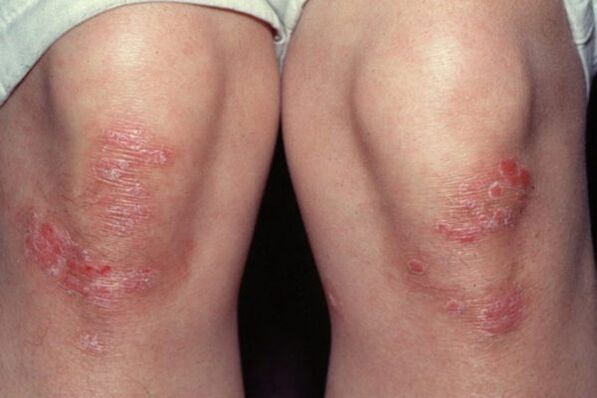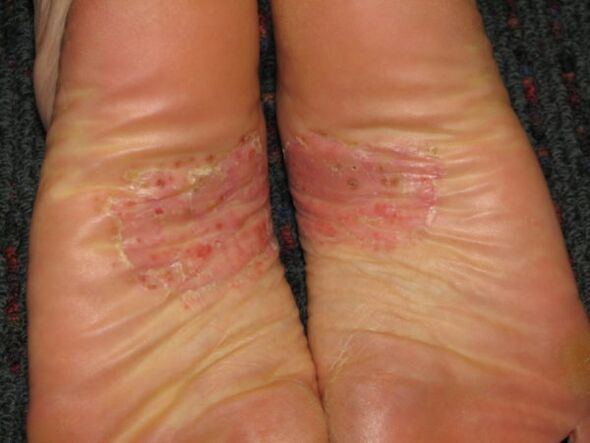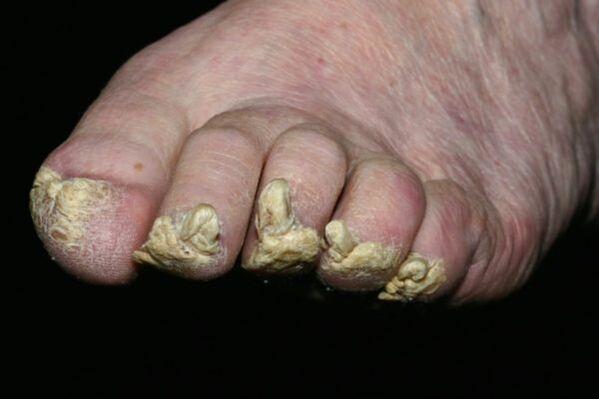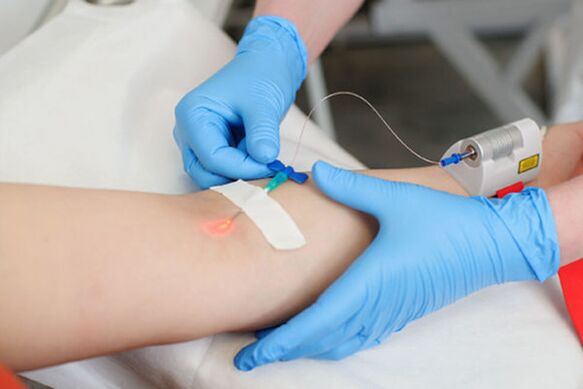Psoriasis of the feet is a common problem. It can occur due to hormonal disorders, a weakened immune system, and other reasons. It can be cured with the help of medicines, folk medicine recipes and physiotherapy procedures.

Causes and risk factors of psoriasis on the legs
Psoriasis of the legs is a condition for which doctors cannot identify the cause. However, possible provoking factors include:
- Heredity. The disease can be inherited (from parents to children).
- Disorders of the work of the central nervous system. Frequent stress leads to disruption of many processes in the body. In many patients, such rashes appear precisely after stressful situations.
- Hormonal disruption in the body. Disruption of the endocrine system leads to metabolic disturbances, which is a factor causing excessive production of skin cells.
- Weakened immunity. Psoriasis develops against the background of infectious diseases. The risk group includes patients who often suffer from viral infections and respiratory diseases (bronchitis, tonsillitis).
- Mechanical damage to the skin.
- Climate change.
- Frequent use of certain drugs.
- The abuse of hygiene products which leads to the destruction of beneficial microorganisms on the skin.
- The use of chemicals.
- Eat foods containing food additives, alcohol.

Classification and symptoms of psoriasis on the legs
There are several types of disease, each with its own symptoms:
- Common (stained, vulgar). The most common type of psoriasis, affecting almost 90 percent of all patients. It manifests as rashes in the form of red spots, which spread quickly on the legs. Small patches, 3 to 4 cm in diameter, if left untreated, can join together and create large areas of rash. It is accompanied by severe itching, bleeding may occur when scratching. A rash on the knees occurs with such symptoms.
- Exudative (pustular). This type is rare and occurs in a more severe form. Repeated relapses are possible. Complex healing therapy takes time. Rashes in the form of pustules with clear liquid often bleed, while the patient's skin is constantly warm. This type is observed on the feet and legs.
- Teardrop-shaped (tip). Not very common. It is characterized by spot rashes that are red or scarlet in color, resembling a drop. Basically, the factor causing the emergence of this species is streptococcal bacteria. The rash is localized on the knees.

- Reverse. During the disease, pale pink spots appear, smooth to the touch. There is no peeling, but sometimes a slight peeling of the skin can be observed. The spots do not go beyond the surface of the skin, they are concentrated on the inner side of the thigh.
- Psoriatic onychodystrophy (nail psoriasis). From the name, it is clear that the disease affects the nail bed and the skin around it. Point depressions appear on the nails, in which the color of the nail plate changes (turns yellow or turns white). Spots appear on them, they become brittle. Sometimes it bleeds under the fingernails. Detachment of the nail from soft tissue occurs - onycholysis. Subsequently, scars appear.
- Psoriatic erythroderma. It is characterized by red rashes, peeling skin, unbearable itching, swelling, and swollen lymph nodes. Erythroderma has a wide range of lesions - from the groin area to the feet.
- Psoriasis on the feet. This type of disease causes a lot of problems for the patient. When walking, sores and cracks appear, which constantly bleed and interfere with walking. The blisters are located on the heels, around the fingernails, on the pads of the fingers and between them. The constant rubbing causes irritation with severe itching and scratching, which can lead to fungal infections. To some extent, sweating contributes to the development of rashes on the feet. Sweat is an excellent breeding ground for the development of pathogens that cause inflammation.
- Psoriatic arthritis (psoriasis of the joints). This type develops not only on the epidermis, but also on the joints. Psoriasis affects the knees and joints of the fingers. The main symptom of the development of arthritis in the legs is curvature of the joints and changes in their size. As a result, the joint and limbs are disturbed (a small bone appears near the finger). The dermis in this place stretches and takes on a burgundy color, swelling is observed.

Drug treatment for psoriasis
Medication for psoriasis depends on the degree of development of the disease.
- Lightweight. For the treatment of a disease of this mild degree, local therapy is used (ointments, creams, gels). Salicylic and zinc ointments give good results. To achieve high results of treatment, complex therapy is used, which includes drugs with hormonal components and vitamins. They use drugs that contain a medicinal substance - dithranol.
- Medium. For the treatment of this degree of the disease, all methods of treatment are important in order to eliminate all the symptoms of the disease. Along with drug therapy, laser therapy, light therapy, as well as plasmaphoresis (removal of toxic substances from the blood) and cryotherapy (cold therapy) are used. In case of complications, corticosteroid ointments are prescribed: hydrocortisone, cortisone.
- Heavy. This degree is the most difficult and requires treatment with all the means and methods that relieve the symptoms of psoriasis on the legs. In these cases, drugs are prescribed to suppress immune responses, antihistamines and antibiotics.
Physiotherapy for psoriasis
Physiotherapy effectively complements the drug treatment of psoriasis. In medical practice, there are several methods of physiotherapy procedures:
- Light therapy for the legs. Ultraviolet radiation is the most effective treatment for psoriasis. The method involves exposure to ultraviolet rays in a medical facility. No side effects were found, it does not affect the body. After light therapy, the plaques are reduced, and in 80% of cases the patient recovers completely.
- Cryotherapy. The method is based on cold processing. The course can last from one to six months. With psoriasis of the legs, a local procedure is prescribed, when the cold affects only certain lesions. These sessions reduce itching and inflammation, promote tissue repair and slow the formation of new scales.
- UV blood count (plasmophoresis). This method in medicine is relatively new, its peculiarity is a result of timely treatment. The essence of the procedure is that a tube is inserted into a vein through which blood is poured into a vessel located in a special device. There, the blood is exposed to ultraviolet rays and then returned. The procedure is carried out with complete sterility.
- Puvatherapy. The method of treatment is prescribed to patients with severe forms of psoriasis. It is based on the use of psoralens - substances that increase the sensitivity of cells to ultraviolet radiation. The method is very effective, after 25 sessions the profuse rashes almost disappear.

Recipes of folk medicine for psoriasis
- Many patients use traditional medicine to treat the disease. It can be tinctures, baths, lotions, decoctions. Various herbs are used to cleanse the skin, such as calendula, chamomile, celandine. They are able to relieve inflammation and the burning sensation.
- Broths. For the broth, you need to use a series (2 tbsp), celandine (1 tbsp), licorice root (2 tbsp) and oregano (1 tbsp). All the herbs are mixed and infused for 20 minutes. The broth is taken orally for half a glass 2 times a day. This remedy is effective for mild psoriasis.
- Ointments. There are many folk recipes for making birch tar ointment.
- Mix birch tar (50 ml) with olive oil (50 ml). Apply the resulting ointment to the sore skin, preferably before bedtime, wrap it with gauze. Rinse off with lukewarm water in the morning.
- Birch tar (30ml), castor oil (30ml), honey (60 grams) and 2 chicken eggs. Mix all the ingredients and refrigerate for 2 days. Apply the ready-to-use mixture every day for a month.
- Thermal baths. Traditional medicine offers the treatment of diseases of the legs, using celandine-based baths. Celandine not only contributes to the removal of rashes, but also eliminates the causes of the manifestation of the disease. The herb is poured with boiling water and infused for an hour. Filter the infusion and add to the foot bath. Bath time does not exceed 15 minutes.

- Compress. In addition, with psoriasis on the legs, compresses from potatoes will help. To prepare such a compress, you need to grate the potatoes and put the prepared composition on your feet, wrapping it with cling film. The duration of the compress does not exceed three hours.
Diet
Diet plays an important role in psoriasis. During severe inflammation, it is necessary to adhere to certain dietary rules. Do not eat smoked, salty and fatty foods. Sweets, citrus fruits and dairy products are also contraindicated in case of illness. The consumption of alcohol is strictly prohibited.
Complications and consequences
Any illness, if left untreated, can lead to serious complications. Psoriasis of the feet can lead to the following consequences:
- the appearance of pain when walking;
- ordinary psoriasis can progress to erythroderma;
- the appearance of other infections;
- violation of metabolic processes;
- decrease in the protective functions of the epidermis;
- violation of thermoregulation of the skin.
Prevention of psoriasis on the legs
If you follow all preventive measures, the disease of psoriasis can be prevented. Prevention recommendations:
- treat your feet with antibacterial and nutritional preparations;
- treat toenails to prevent fungal infections;
- sun treatments;
- when wearing closed-toe shoes, you need to ventilate your feet;
- frequent physical activity.
The main rule in the prevention of any disease is observance of a healthy lifestyle.























